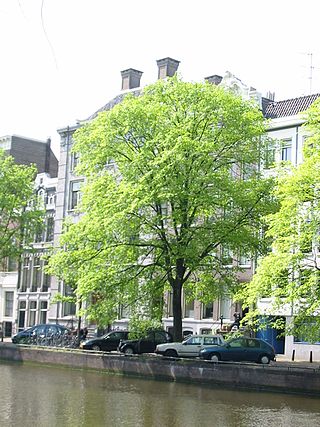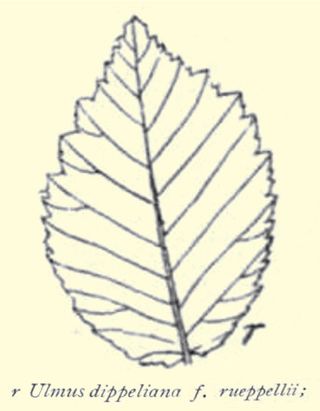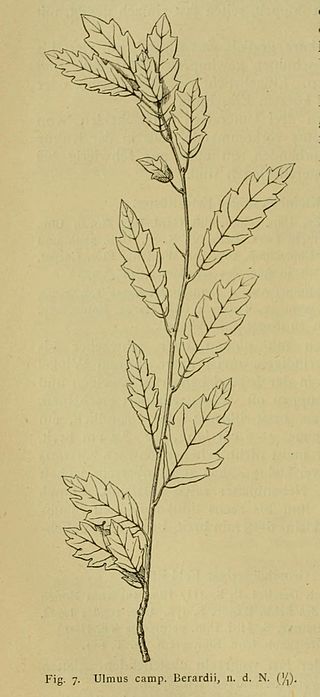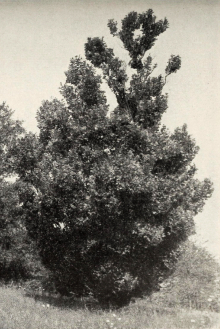
The hybrid elm cultivar Ulmus × hollandica 'Belgica', one of a number of hybrids arising from the crossing of Wych Elm with a variety of Field Elm, was reputedly raised in the nurseries of the Abbey of the Dunes, Veurne, in 1694. Popular throughout Belgium and the Netherlands in the 19th century both as an ornamental and as a shelter-belt tree, it was the 'Hollandse iep' in these countries, as distinct from the tree known as 'Dutch Elm' in Great Britain and Ireland since the 17th century: Ulmus × hollandica 'Major'. In Francophone Belgium it was known as orme gras de Malines.
The hybrid elm cultivar Ulmus × intermedia 'Coolshade' is an American hybrid cultivar cloned from a crossing of the Slippery, or Red, Elm Ulmus rubra and the Siberian Elm Ulmus pumila at the Sarcoxie Nurseries, Sarcoxie, Missouri, in 1946. At Arnold Arboretum, where there was a specimen, herbarium material was labelled Ulmus pumila 'Coolshade'.

The hybrid elm cultivar Ulmus 'Den Haag' is a Dutch development derived from a chance crossing of the Siberian Elm cultivar Ulmus pumila 'Pinnato-ramosa' and the Belgian Elm Ulmus × hollandica 'Belgica'. S. G. A. Doorenbos (1891-1980), Director of Public Parks in The Hague, finding that seeds he had sown in 1936 from the Zuiderpark 'Pinnato-ramosa' had hybridized with the local 'Belgica', selected six for trials. The best was cloned and grafted on 'Belgica' rootstock as 'Den Haag'; it was planted first in that city, then released to nurseries elsewhere in the Netherlands. The other five were also planted in The Hague.

Ulmus minor 'Rueppellii' is a Field Elm cultivar said to have been introduced to Europe from Tashkent by the Späth nursery, Berlin. Noted in 1881 as a 'new elm', it was listed in Späth Catalogue 73, p. 124, 1888–89, and in subsequent catalogues, as Ulmus campestris Rueppelli, and later by Krüssmann as a cultivar.

The elm cultivar Ulmus 'Berardii', Berard's Elm, was raised in 1865, as Ulmus Berardi, from seeds collected from large specimens of "common elm" growing on the ramparts at Metz, by an employee of the Simon-Louis nursery named Bérard. Carrière (1887), the Späth nursery of Berlin and the Van Houtte nursery of Gentbrugge regarded it as form of a Field Elm, listing it as U. campestris Berardii, the name used by Henry. Cheal's nursery of Crawley distributed it as Ulmus nitens [:Ulmus minor] 'Berardii'. Smith's of Worcester preferred the original, non-specific name, Ulmus 'Berardii'.

The elm cultivar Ulmus 'Koopmannii' was cloned from a specimen raised from seed sent from Margilan, Turkestan by Koopmann to the Botanischer Garten Berlin c. 1880. Noted in 1881 as a 'new elm', it was later listed by the Späth nursery, catalogue no. 62, p. 6. 101, 1885, as Ulmus Koopmannii, and later by Krüssmann in 1962 as a cultivar of U. minor. Margilan is beyond the main range of Ulmus minor. Augustine Henry, who saw the specimens in Berlin and Kew, believed Koopmann's Elm to be a form of Ulmus pumila, a view not shared by Rehder of the Arbold Arboretum. Ascherson & Graebner said the tree produced 'very numerous root shoots', which suggests it may be a cultivar of U. minor. Until DNA analysis can confirm its origin, the cultivar is now treated as Ulmus 'Koopmannii'.
The elm cultivar Ulmus 'Rugosa' [:'wrinkled', the leaves], was first listed in Audibert's Tonelle (1817), as "U. campestris Linn. 'Rugosa' = orme d'Avignon [Avignon elm] ", but without description. A description followed in the Revue horticole, 1829. Green (1964) identified this cultivar with one listed by Hartwig and Rümpler in Illustrirtes Gehölzbuch (1875) as Ulmus montana var. rugosaHort.. A cultivar of the same name appeared in Loddiges' catalogue of 1836 and was identified by Loudon in Arboretum et Fruticetum Britannicum (1838) as Ulmus montana var. rugosaMasters, Masters naming the tree maple-bark elm. Ulmus montana was used at the time both for wych cultivars and for some cultivars of the Ulmus × hollandica group.
The elm cultivar Ulmus 'Globosa' was first described in the Späth nursery catalogue of 1892–93. Considered "probably Ulmus carpinifolia " by Green
The elm cultivar Ulmus 'Tortuosa'Host, the Wiggly Elm, was described by Host in Flora Austriaca (1827) as Ulmus tortuosa, from low, twisted, small-leaved trees that grew in the hilly districts of Hungary. A contemporary herbarium specimen (1833) from Central Europe labelled U. tortuosaHost appears to show small field elm-type leaves. Henry distinguished 'Tortuosa' Host from Loddiges' and Loudon's U. tortuosa, which he identified with Ulmus 'Modiolina', "l'orme tortillard" of France. Henry noted, however, that abnormal sinuous or zigzagging growth "might occur in any kind of elm", and herbarium specimens of elms labelled 'Tortuosa' range from U. minor cultivars to hybrid cultivars, some treated as synonymous with 'Modiolina'. A large-leaved U. campestris tortuosa was described by David in Revue horticole (1846), while a hybrid var. tortuosa cultivar from Louveigné, Belgium, with twisted trunk and large leaves, was described by Aigret in 1905. An U. campestris suberosa tortuosa was marketed in the 1930s by the Hesse Nursery of Weener, Germany, by its description a contorted form of corky-barked field elm.

The Siberian Elm cultivar Ulmus pumila 'Pendula' is from northern China, where it is known as Lung chao yü shu. It was classified by Frank Meyer in Fengtai in 1908, and introduced to the United States by him from the Peking Botanical Garden as Weeping Chinese Elm. The USDA plant inventory record (1916) noted that it was a "rare variety even in China". It was confirmed as an U. pumila cultivar by Krüssmann (1962).

The hybrid elm cultivar Ulmus × hollandica 'Gaujardii', one of a number of cultivars arising from the crossing of Wych Elm U. glabra with Field Elm U. minor, was raised by the Gaujard-Rome nursery of Châteauroux, France, in the 1890s as Ulmus Gaujardii and was described in the 1898 Kew Bulletin and Wiener illustrirte Garten-Zeitung. It won first prize in the International Horticultural Exhibition in Saint Petersburg, Russia, in 1899 and a silver medal in the Heemstede Exhibition, The Netherlands, in 1925. From the early 20th century it was distributed by the Späth nursery of Berlin as Ulmus montana Gaujardi, and in the interwar years by the Boccard nursery of Geneva as Ulmus campestris Gaujardi. It appeared in Unsere Freiland-Laubgehölze in 1913, but without description.

The elm cultivar Ulmus × hollandica 'Haarlemensis', said to have been grown from seed c.1880 from a hybrid parent tree, was first listed by Springer as U. campestris haarlemensis in 1912.

The Field Elm cultivar Ulmus minor 'Umbraculifera Gracilis' was obtained as a sport of 'Umbraculifera' by the Späth nursery of Berlin c.1897. It was marketed by the Späth nursery in the early 20th century, and by the Hesse Nursery of Weener, Germany, in the 1930s.

The putative Wych Elm cultivar Ulmus glabra 'Latifolia' was identified in Audibert's Tonelle (1817) as U. campestrisLinn. [ = U. glabraHuds.] latifolia. The tree is reputed to have originated circa 1750 in or around Mechelen, and to have been widely planted throughout Belgium. A 1912 herbarium specimen from Oudenbosch, however, shows a hybrid leaf labelled Ulmus hollandica latifolia.
The elm cultivar Ulmus 'Lombartsii' is considered "possibly Ulmus × hollandica or Ulmus carpinifolia " by Green (1964). The tree was raised by Lombarts Nurseries at Zundert, Netherlands, circa 1910.

The elm cultivar Ulmus 'Scampstoniensis', the Scampston Elm or Scampston Weeping Elm, is said to have come from Scampston Hall, Yorkshire, England, before 1810. Loudon opined that a tree of the same name at the Royal Horticultural Society's Garden in 1834, 18 feet (5.5 m) high at 8 years old "differed little from the species". Henry described the tree, from a specimen growing in Victoria Park, Bath, as "a weeping form of U. nitens" [:Ulmus minor ]; however Green considered it "probably a form of Ulmus × hollandica". Writing in 1831, Loudon said that the tree was supposed to have originated in America. U. minor is not, however, an American species, so if the tree was brought from America, it must originally have been taken there from Europe. There was an 'American Plantation' at Scampston, which may be related to this supposition. A number of old specimens of 'Scampstoniensis' in this plantation were blown down in a great gale of October 1881; younger specimens were still present at Scampston in 1911.

The hybrid cultivar Ulmus 'Androssowii'R. Kam., an elm of Uzbekistan and Tajikistan sometimes referred to in old travel books as 'Turkestan Elm' or as 'karagach' [:black tree, = elm], its local name, is probably an artificial hybrid. According to Lozina-Lozinskaia the tree is unknown in the wild in Uzbekistan, and apparently arose from a crossing of U. densa var. bubyrianaLitv., which it resembles, and the Siberian Elm Ulmus pumila. It is sometimes listed as Ulmus × androssowii.

The Siberian elm cultivar Ulmus pumila 'Pinnato-ramosa' was raised by Georg Dieck, as Ulmus pinnato-ramosa, at the National Arboretum, Zöschen, Germany, from seed collected for him circa 1890 in the Ili valley, Turkestan by the lawyer and amateur naturalist Vladislav E. Niedzwiecki while in exile there. Litvinov (1908) treated it as a variety of Siberian elm, U. pumilavar.arborea but this taxon was ultimately rejected by Green, who sank the tree as a cultivar: "in modern terms, it does not warrant recognition at this rank but is a variant of U. pumila maintained and known only in cultivation, and therefore best treated as a cultivar". Herbarium specimens confirm that trees in cultivation in the 20th century as U. pumilaL. var. arboreaLitv. were no different from 'Pinnato-ramosa'.
The elm cultivar Ulmus 'Turkestanica' was first described by Regel as U. turkestanica in Dieck, Hauptcat. Baumschul. Zöschen (1883) and in Gartenflora (1884). Regel himself stressed that "U. turkestanica was only a preliminary name given by me; I regard this as a form of U. suberosa" [:U. minor ]. Litvinov considered U. turkestanicaRegel a variety of his U. densa, adding that its fruits were "like those of U. foliaceaGilibert" [:U. minor].
The hybrid elm cultivar Ulmus × hollandica 'Viminalis' [:osier-leaved] was listed by the Späth nursery of Berlin as Ulmus scabraMill. var. viminalis in 1890 and as Ulmus montana viminalis from 1892. Though Späth's catalogues stated that it was "also distributed under the name planera aquatica", it remained in his lists under 'elm' and was accessioned by the Dominion Arboretum, Ottawa, and by the Royal Botanic Garden Edinburgh as an elm cultivar. A similar misidentification occurred in the mid-20th century, when the Siberian elm cultivar Ulmus pumila 'Poort Bulten' was for many years commercially propagated under the name Planera aquatica or 'water elm'. As the leaves of osier or Salix viminalis, however, differ markedly from those of Planera aquatica, being long, thin and tapering at both ends, Spath's name 'Viminalis' for this elm cultivar confirms that its leaves were not Planera-like. The probable explanation for the early distribution name is that Planera was the old name for Zelkova, a close relative of elm with willow-like leaves. It is therefore unlikely that 'Viminalis' was related in any way to the 19th-century elm cultivar Ulmus 'Planeroides'.


















